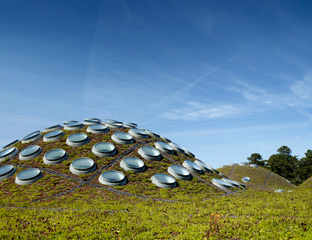
The California Academy of Sciences, which reopened in San Francisco’s Golden Gate Park this past fall, is now in a new building that resembles a high-style space station — all glass and recycled steel and capped with an undulating green roof that shelters a planetarium, an aquarium, a natural-history museum and a research center — an improvement over its former incarnation as a motley complex of mismatched structures. Designed by superstar architect Renzo Piano to be the planet’s greenest museum (it is Platinum LEED certified, the highest rating), it’s also thrillingly futuristic, home to the world’s largest digitally controlled (and partially solar-powered) planetarium and such eco-innovations as insulation made of recycled blue jeans, and skylights and windows that open and close automatically to regulate the building’s temperature. And that’s just the structure — wait until you see what’s inside. Here, five tips on how to maximize a visit.
1. Hit the planetarium, pronto. As soon as you enter the museum, head to the planetarium kiosk and secure tickets to one of the hourly shows, which fill up early. “Fragile Planet,” the presentation on view, is narrated by Sigourney Weaver. Did you know that Earth occupies a “prime piece of solar-system real estate”?
2. Wear fuchsia. A spiral walkway corkscrews through the rain-forest dome, where the habitats of Madagascar, Borneo, Costa Rica and the Amazon have been re-created and stocked with gape-mouthed pitcher plants, sticky-fingered geckos and other fantastical creatures. Brightly colored butterflies flit throughout the space, occasionally alighting on visitors. If you want a closer encounter, try wearing reddish-purple clothing; it’s said to attract them.
3. Get analyzed. More than simply a museum, the California Academy of Sciences is also a thriving research institution, with 100 scientists on-site and twenty million specimens in storage. Check out the scientists’ latest discoveries at the “Islands of Evolution” exhibit, and then head to the Naturalist Center, on the third floor, with something for the staff to puzzle over and identify: a leaf from your backyard or a rock from your farthest-flung vacation.
4. Bring your binoculars. From the open-air observation deck, you can spy distant birds and bees buzzing among the poppies, strawberries and other native plants on the surrounding 2.5-acre Living Roof. This blooming green carpet insulates the building and absorbs rainwater, keeping millions of gallons out of the city sewer system. While you’re up there, take a peek at the solar panels along the building’s perimeter; they provide up to 10 percent of the museum’s energy needs.
5. Stay for dinner. The museum’s underlying message — that the earth is fragile and that we should be mindful of our actions — is expressed most deliciously in its two restaurants, which focus on local, organic and seasonal produce and seafood. The café is perfect for a casual lunch, while the subterranean Moss Room stays open late and offers a more formal experience, turning out sophisticated dishes, like guinea fowl with almond curry and root vegetables, in the shadow of a dramatic vertical moss garden. 55 Music Concourse Drive; 415-379-8000; calacademy.org.
